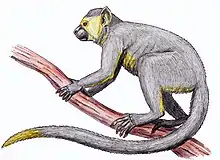Dionysopithecidae
Dionysopithecidae is an extinct family of fossil catarrhines and the earliest-known and most primitive members of the Pliopithecoidea superfamily, with fossils in Sihong in China dating to 18–17 million years ago for species Dionysopithecus shuangouensis and Platodontopithecus jianghuaiensis.[1]
| Dionysopithecidae Temporal range: | |
|---|---|
| Scientific classification | |
| Domain: | Eukaryota |
| Kingdom: | Animalia |
| Phylum: | Chordata |
| Class: | Mammalia |
| Order: | Primates |
| Suborder: | Haplorhini |
| Infraorder: | Simiiformes |
| Parvorder: | Catarrhini |
| Superfamily: | †Pliopithecoidea |
| Family: | †Dionysopithecidae |
| Genera | |
| |
A single lower molar found in Ban San Klang in Thailand is similar to those found in Sihong but sufficiently different to be considered a different species, Dionysopithecus orientalis.[1]
They are sometimes treated as a subfamily of Pliopithecidae as 'Dionysopithecinae'.[2]
References
- Harrison, Terry (2012). "Chapter 20 Catarrhine Origins" (PDF). In Begun, David (ed.). A Companion To Paleoanthropology. Wiley Blackwell. ISBN 978-1-118-33237-5. Archived from the original on 2023-09-05.
- Harrison, T; Gu, Y (1999). Taxonomy and phylogenetic relationships of early Miocene catarrhines from Sihong, China.
- The Illustrated Encyclopedia of the Prehistoric World page 434.
Wikispecies has information related to Pliopithecidae.
This article is issued from Wikipedia. The text is licensed under Creative Commons - Attribution - Sharealike. Additional terms may apply for the media files.



